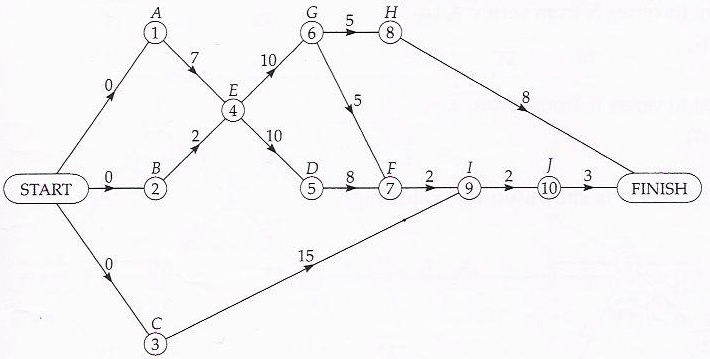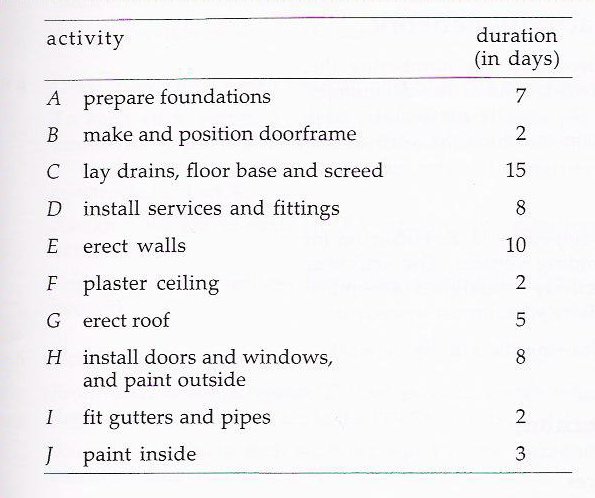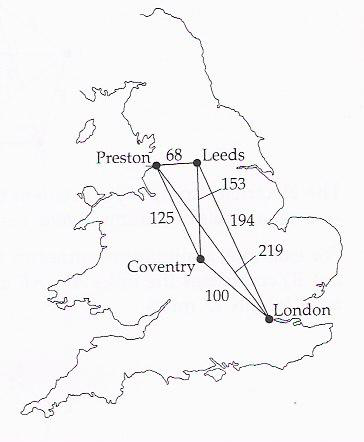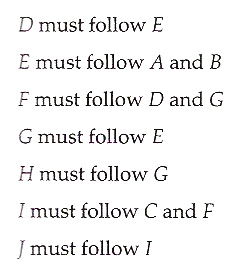Combinatoriality, or combinatorics as a study field, is concerned with how discrete material or tasks can be combined in patterns. This includes enumerating all the possible permutations of an identified set of material/tasks.1 While considering such sequential possibilities in performing arts may be relatively new, the topic of sequential combinatoriality is a well-established domain in science. It is in this respect that I wish to make reference to mathematical models of optimization and operations research. A simple example of the travelling salesman problem is not dissimilar to the child’s morning routine algorithm. The travelling salesman problem is as follows:
A travelling salesman wishes to visit a number of cities and return to his starting point, selling his wares as he goes. He wants to select the route with the least total length. Which route should he choose? And what is its length?
In principle, we can solve such problems by looking at all possible routes and choosing one with the least total length. But the trial-and-error approach becomes difficult if the number of cities in creases significantly. Rather surprisingly, there is no known efficient systematic procedure for the travelling salesman problems. However, several efficient procedures are known that give an approximation to the minimum length of a route that visits all the cities and returns to the starting point. One such procedure is a heuristic algorithm:
Step 1 Choose any city and find the path of least distance emerging from it. Draw the corresponding two cities as points and join them by two lines, to form a cycle. [I have chosen Leeds as a starting point.]
Step 2 Find the path of least distance joining a drawn city A to a city B not currently drawn. Draw the new city B on the edge of the cycle immediately after A, moving in a clockwise direction.
Step 3 Repeat Step 2 until all the cities appear in the cycle. The total distance of the cycle is at most twice the length of the requested minimum (but not necessarily the minimum distance).
There are at least two other algorithms for the travelling salesman problem. These procedures are concerned with efficiency, and efficiency can be measured in many different ways (for example the length of time can be a criterion instead of distance in the above example). These procedures can be applied to a wide variety of problems with different criteria. It seems plausible to find a modified algorithm to problems in a musical situation too, following the principle of observing affordances in differing context. For example, assuming a similar, finite number of required tasks in learning to play music, mathematical concepts of ‘distance’ and ‘time’ may find their equivalent in musical ‘difficulty’ and ‘effort’ in solving the problem.
Rather than delving into the adoptive use of this algorithm, a quick survey of other available models is worthwhile in order to understand the breadth of the concept of combinatoriality as applicable tool in practical situations. Another useful model is that of critical paths. Critical path is an optimum route that is taken while ensuring all the identified tasks are completed. Here is an example of an activity network.
An activity network can be used to find an optimum schedule for a project with a number of tasks. Here is an example of a building construction project. In this circumstance, tasks are called activities.
First we have a list of activities and durations. We also have rules of precedence that outline which activity must follow which one.
The circled number denotes the order in which activities are carried out over the timeline. In other words, this network reads like a musical system, in which the activities on the same vertical line take place at the same time and the activities to the right take place later than those on the left side.
We usually want to know the minimum time needed to complete any project. From an activity network like this, we can calculate the minimum completion time for it. To do this, we find a longest path, called a critical path, from the starting point to the finishing point. By a longest path, we mean a path (or a sequence) for which the sum of the times associated with the length of all the essential activities has the largest possible value. The minimum completion time is equal to the length of a longest/critical path.
Interests in procedural order came first from industry: different project-schedules often have significant consequences for duration and costs. Methods for critical path analysis are powerful tools in such situations for mapping out optimum schedule. It was developed in the 1960s as Operational Analysis in industry for achieving maximum productivity in manufacturing sectors. (More detailed illustrations can be found, for example, in Lockyer’s 1964 book on the subject.)
This example is concerned with the minimum length of the project without causing deficiency. Although the question of what is considered ‘optimum’ in each situation has to be considered carefully, the principle of algorithmic approach of this kind has had a considerable influence on how we think about ‘efficiency’ in general: for example, I see the same principle in operation when we plan orchestral rehearsals where ‘cost’ is a significant factor.
But when combinatoriality principle is applied to musical situations, there are questions of artistic quality in addition to those of achieving satisfactory products with efficiency. Performance is a combinatorial art – the quality of which depends on the manner of assembling finite tasks.
In 2014 I conducted a friendly survey with ensemble insomnio, a Netherlands-based new music ensemble, with whom I play regularly. I was curious to know how my fellow musicians learned the repertoire and managed their own practice before the group rehearsals. There were two questions: 1) what do you do first when you receive your part? 2) at which point do you put loose pages of a PDF file together into a booklet?
The answer to the first question starts the same for everyone: you look at your part quickly to gain an overall image of the piece to understand how long the piece is, how difficult or easy it looks, and capture any visible features you can observe on the page. The next step varies considerably, depending on which instrument you play: the percussion and woodwind players look for information about which instruments they need; this does not apply to the string players and pianist – the string players start looking for any passages that use high positions, while the pianist looks for any unusual configurations on the page or whether she would need to play inside the piano.
For the percussionist, understanding the range of required instruments and how to lay them out on stage is of paramount importance. Once he understands his performance ‘site’ and pathways between the instruments as choreography, he has almost ‘learned the piece’, even before starting to look at the actual notes.
Our flautist said that she would look for special techniques after checking which instruments are used. I asked her why – as this is not what I would do as a violinist. She said it was because special techniques are what make the new flute music distinct from the older ones, and understanding the range of sounds is very important for her.
The pianist said she would start practicing page by page. This, in her case, means practicing one musical passage at a time (because the piano part covers a shorter length of music in one page), and she wants to know the character of each passage.
The viola player described his own method as follows: after having had an overview of his part, he puts together all the pages and makes his own booklet. He starts practicing after that. At this point, he may not have played a single note but he has an understanding of the piece (or his contribution to it). He thinks he has done approximately 60% of his preparation by this point, despite not having touched his instrument.
This leads to the second question I asked the players: at which point do you put your sheet music together? The pianist and flautist said that they would do so just before the first group rehearsal, after having practiced their parts with loose leaves. The percussionist said he would do so during group rehearsals, and he would have to try out if his layout of instruments - and sheet music for each instrument - would be practical or not, in the context of a performance. He may never put pages together in some cases, because each performance occasion and venue often changes his performance site. In these cases he has to work out a new site for each performance.
In these interviews each player described her/his approach as ‘how I do it’ – meaning it is just her/his way, rather than the way it should be done. Each player customizes her/his own process. Their indivudual methods are the results of making combinatorial choices informed by experience. It is important to note that these methods are choices rather than default models arising from lack of capacity. These players can learn new pieces following a different approach, as we often workshop new pieces ‘on site’ as a group, where there is no individual preparation time. What interests me is each player’s ‘mindfulness’ about detail that renders her/his approach individual. It is important for her/him, and holds a key to her/his excellence as a player.
Everyone’s method for learning is personalized. But it is NOT simply a question of taste and convenience that we use a particular method. It changes the outcome. The subtle differences that different processes bring to the outcome influence the qualities of performance: for example, the fluency in the playing, the timbral variety and effectiveness, the characterisation in passages, the capacity to coordinate better with the fellow musicians, and the overall understanding of the individual's contribution to the whole, amongst others.
The occasions in which musicians make methodological choices can be found everywhere everyday, not only in ensemble performance or in the preparation for a concert. For instance, string players go through the practice of how we decide on fingering and bowing choices every day. Some of the choices are made instinctively, some are conscious; but the choices made affect the result in a palpable way in terms of fluency, stylistic articulation, reliability, to mention three critical values in classical music performance.
We see how professional musicians assemble a performance through highly accomplished methodology with critical thinking in the process. Combinatoriality is perhaps the most pragmatic concept among the three I am examining in this exposition, because it manifest itself as methodology. It is more visible and hence discernable. But it is also important to remember its relation to the concept of affordance, or more specifically to the ways in which musicians understand the affordances in a given material or situation, because, without which combinatoriality would remain a merely theoretical construct for us.







